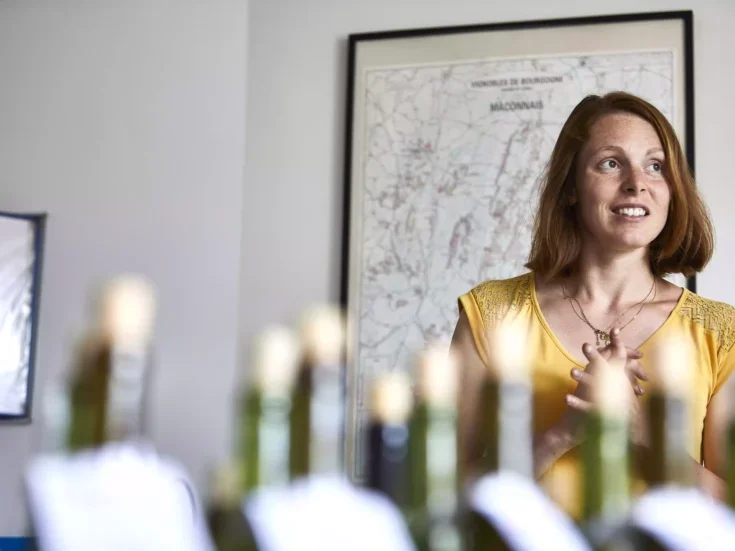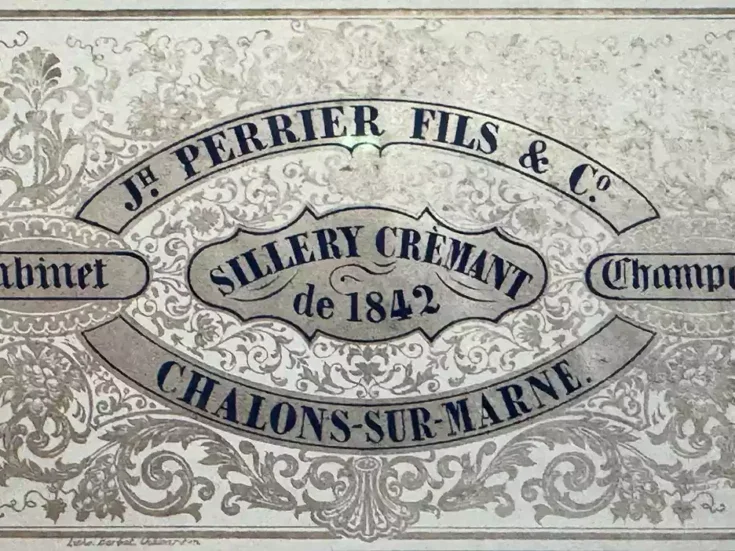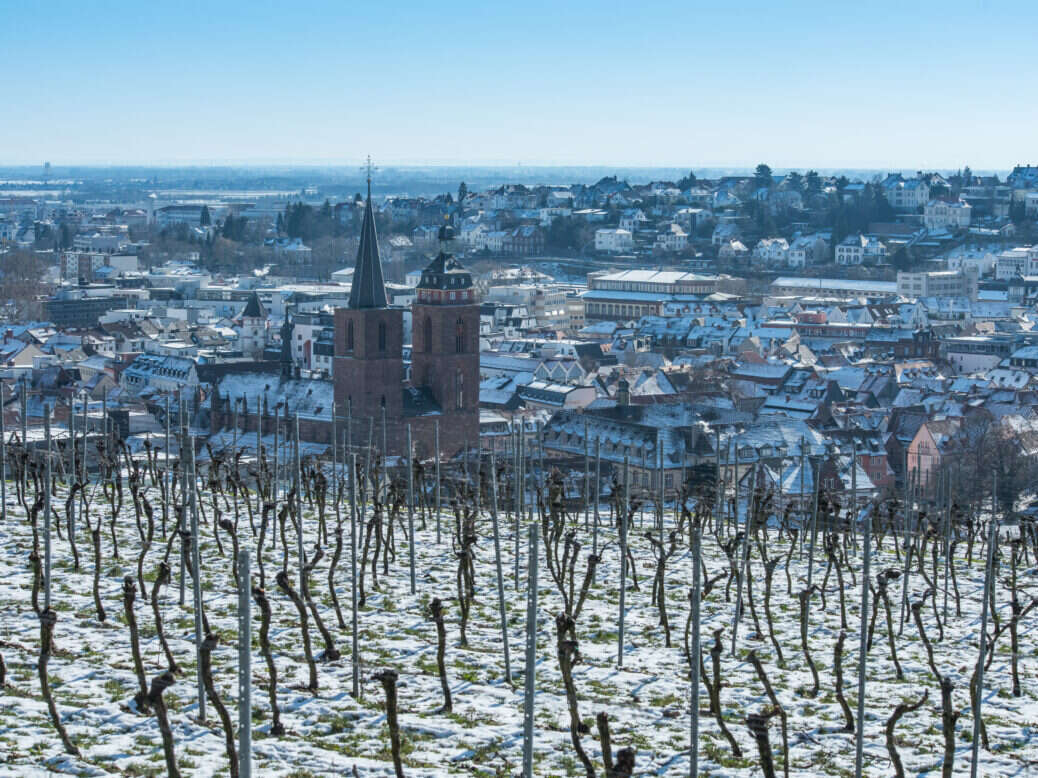
Terry Theise begins his two-part review of the wines of Müller-Catoir with an overview of the great Pfalz estate’s genre-changing Spätburgunder reds.
This year marks the 20th anniversary of the arrival of Martin Franzen as cellarmaster at this venerable estate. That’s an entire generation of drinkers, writers, and customers who’ve only known the estate under Franzen’s careful guidance.
There is, let’s say, a celebrated history here, but I don’t think we ought to write about it any more. It muddies the waters and obscures the purity of the modern narrative. Yet it isn’t as if the new broom swept entirely clean. The tradition of not only cultivating but also cherishing varieties such as Scheurebe, Muskateller, and Rieslaner has been carried forward, thankfully. Nor does this conflict with Franzen’s central focus on Riesling—and recently, Spätburgunder. It simply adds complexity to the portrait.
The Pfalz is a place of cheery commotion these days, especially in the “classic” corridor consisting of the triumvirate of Deidesheim, Forst and Wachenheim. The first of these is home to Bassermann-Jordan, Von Buhl, and to those impassioned radicals at Von Winning, who have upended every existing notion of what German Riesling could be. Forst in turn is home to several excellent small growers, while Wachenheim offers up both Loosen’s J.L Wolf estate, and of course the resurgent youthful team at Bürklin-Wolf. These aren’t the only top estates in the region, of course; there’s Knipser and Rebholz among others.
And then there’s Müller-Catoir, rather off the main drag, up the hill below the villa, cultivating an air of remove that can suggest the monastic, and certainly indicates the introverted. Proprietor Phillip David Catoir will demur, and he’s certainly doing more outreach than did his forbears. But perhaps he’ll forgive my observing that among the most important producers in the Pfalz, Müller-Catoir is the least in-the-mainstream. And this is also true of the wines, stylistically.
Martin Franzen’s wines are diligently explicit but not overtly so. The Rieslings especially are interior wines, and as such they stand out in the Pfalz, a place of sometimes-bellowing extroverts. When Martin arrived, the standard rap was his wines were “like Mosel wines,” since he hails from a Mosel family. This truism was specious and inaccurate, (not to mention Mosel wines have all the affect in the world) but it seemed to stick as a dismissive shorthand. Among the society of significant reviewers, only Schildknecht and Pigott saw the wines clearly.
Another critical error was to judge the estate exclusively from its Rieslings. As diffident as these might (plausibly) appear, Franzen carried on the work of his predecessor in making one of the few greatest dry Muscats in Europe, and certainly in continuing to set the standard for Scheurebe. And then we have the Rieslaner to contend with, and if you’re thinking “But these are ancillary grapes,” well shame on you. To understand Müller-Catoir you have to engage with its entirety, and these Muscats and Scheurebes and Rieslaners are—I don’t hesitate to claim it—great wines. Their quality is not exceeded by anyone else making wines from those grapes. If the wines are relatively extravagant, they are by no means radical. They are classics.
But what of the Rieslings, after all? A few years ago Franzen began to want to “open” them up, to render them more animate and more approachable in their early youth. This was discernible in the warm vintages 17-18-19 but less so in 20-21—but what does it matter in any case? Franzen, who is gregarious and unpretentious, seems to enjoy an ethereal streak where his wines are concerned. Yet even that is facile. He really wants to refine the wines are far as is sensually possible, and in so doing he touches upon the ethereal incidentally. Yet even when the wines are as expressive as the human mind can ascertain, they have a piping, fluting chirrup of melody that you may not appreciate if you need your shoulders shaken.
Recently the estate has entered the fray with Pinot Noir. But being Müller-Catoir, they’ve done so in such a way as to suggest a new language for that variety to speak.
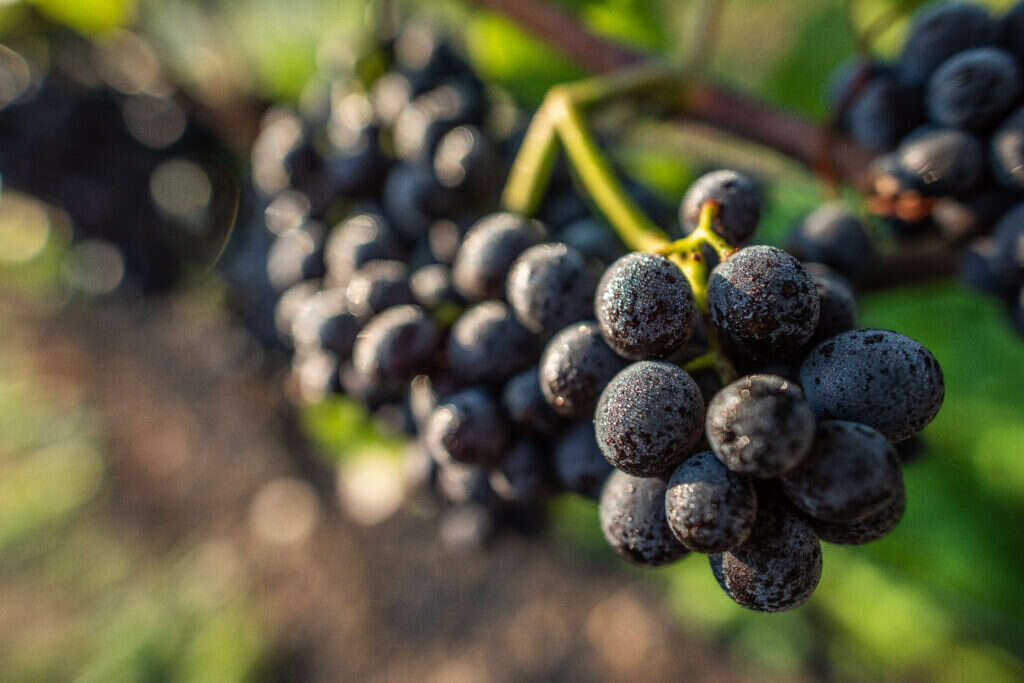
Müller-Catoir Haardt Spätburgunder 2020 +
This is the village-wine from Haardt, which is officially a suburb of Neustadt. You’ll have heard of its prominent sites Bürgergarten, Herrenletten and Herzog.
We have a limpid cherry color but no dearth of ripeness (13.5%) and I doubt that Franzen chaptalized it. Given his general wish to micro-pixilate flavors, the precision of the PN fruit aromas won’t shock you. Nor will the lack (if “lack” it is) of opulence or flirtatious elements.
Yet the palate will surprise you with its silken sensuality and with a fruit-sweetness that’s nearly adorable. An open texture suggests the use of barrels—I’d guess large ones (1,000 liters) and I’d also guess they are not well-used. The diligent clarity is almost caricaturized from the Jancis glass, from which a mintyness and smoke arise, feinting toward Blaufränkisch. (It’s said that mature Blaufränkisch starts to resemble Pinot Noir, so this isn’t as far fetched as it may seem.)
The wine is sophisticated but not aloof; it’s both impressive and enticing, a kind of elemental PN, full of complexity. At the end there’s a salty, almost limestony grip guided by a jot of crushed stones and tannin and even dried flowers. I’m sitting here not quite able to believe, or even to understand, how good this is.
Tasting it for the third time, and using the Spiegelau “red wine” stem, which tends to emphasize umami and mid-palate. But like all these wines, this one is relatively inert over the days, which I don’t mind at all. If anything it seems more silken and floral, but I may be reading that in. You know how wild lavender is a curious overlap of the floral and the feral? This lovely wine straddles the line between spicy (fennel and caraway and anise seeds) and flowery (veering toward the pungent, like day lilies).
I never tasted anything like this. Given that anyone who makes Pinot Noir has Burgundy as a paradigm or lodestar, even people who protest they’re “not trying to make Burgundy,” this tastes like it was made by someone who never tasted Burgundy and doesn’t even know it exists. It is a beautifully weird PN, painted upon a blank canvas, referring to nothing but itself, and speaking a language of make-believe.
Müller-Catoir Mussbach Spätburgunder 2020 +
Another village-level wine, a little less ripe than the above (13%); the color is darker and the wine smells bloodier, and more (I hate to say it) “Burgundian.” It’s expressive and clearly delicious, juicy and redolent of cêpes and summer truffle.
This is a language we know. The wine is less studious, more roasted, more hospitable and warm and enveloping. Oak is also more overt, which makes the wine a little facile, but it’s senseless to resist its seductiveness, albeit it swims in the mainstream with lots of other German PNs. It’s an upstanding citizen of that world, mind you, but it’s also popular and gregarious.
And that said, in turn, it is also silken and detailed, markedly so given its creamy texture. Curiously, as it sits in the glass it gets stonier and more peppery, encouragingly. I suspect this will surprise me when I taste it again tomorrow.
Well, it does and it doesn’t. It remains disarmingly delicious, yet it continues showing a host of suggestive subtexts. Oak is prominent but neither unbalanced nor gaudy.
Müller-Catoir Neustadt “V” Spätburgunder 2020 +
Still officially a village-wine, but the taller bottle (and the enigmatic “V”) suggest we’re stretching higher now. Speaking of which, the letter that looks like a “B” in the Fraktur is actually a “V” and it stands for Vogelsang, the cadaster holding Catoir obtained, is developing, and which will eventually be a “GG” when the vines reach the necessary age. The soil is fossil-bearing limestone (“Muschelkalk”).
Fragrances are more adamant, darker, rockier—and woodier.
The palate is Very-Serious-Business. If you took the limestony bite from red Burgundy and took away every trace of animality or earthiness or even spices, you might arrive here, at a kind of primordial Pinot, as if the grapes were picked by well trained dinosaurs.
It has more of the stuff we all pay more money for, but I wonder whether it’s actually “better.” It depends on the degree you’re willing to pony up for intensity, and most of us would find there’s more to this in every way. There is saliently more tangible structure, some of which has to do with oak tannin, but a lot of nuances ride along that spine of grip.
I drank a bottle of 2013 Clos Saint Denis from Stephane Magnien last night—lucky me! (We had some pintades and a Burgundy truffle thanks to a sale at D’Artagnan….) For all the profundity of the Burgundy, it was something you wished to absorb into your body, whereas this wine, delicious as it is, is something you wish to engage with your mind. It’s like someone reading a complicated poem and suddenly the obscure syntax makes sense and you get it.
I can imagine someone saying it’s too woody, or that it’s more Tempranillo than PN, or any number of things we might glean because the wine is so explicit, like tweezer-food in a glass.
Müller-Catoir Herzog Spätburgunder 2020
Now the single vineyard (Erste Lage in the parlance) and ostensibly the top of the quartet. The color, though, is happily limpid—I like PN like that.
I thought we might be dealing with cask once more, and we are. It’s neither crude nor blatant, but I’m always a wee bit distressed when a vintner thinks this is the dialect that “must” be spoken to indicate your wine is Serious. Yet within its idiom, it’s a successful and tasty wine, and that in turn is because Martin Franzen doesn’t seem to know how to make a wine that isn’t transparent and articulate. I mean, it’s a luxury for me to focus on my dismay, considering the many ways this wine might have been vulgar and sloppy.
Among this impressive quartet, this is the least upfront of them. The flavors of the other three come down from above; this comes up from below. It seems to be hiding its cards. It’s a little more fleeting on the finish. It’s the saltiest among them.
All the wines are smart and lovely, and I judge them more or less as equals. Yet the one I like the most is the first one, the original, the uncanny, the sui generis. Fine, right? I like the waifs. Here again, we get more juju with oxygen, more counterpoint to the woody sweetness, and we have a more deftly poised wine overall than, for example, the Mussbach. It is churlish of me to observe the wine is perhaps too plausible, but for now, I’ve seen this show before.
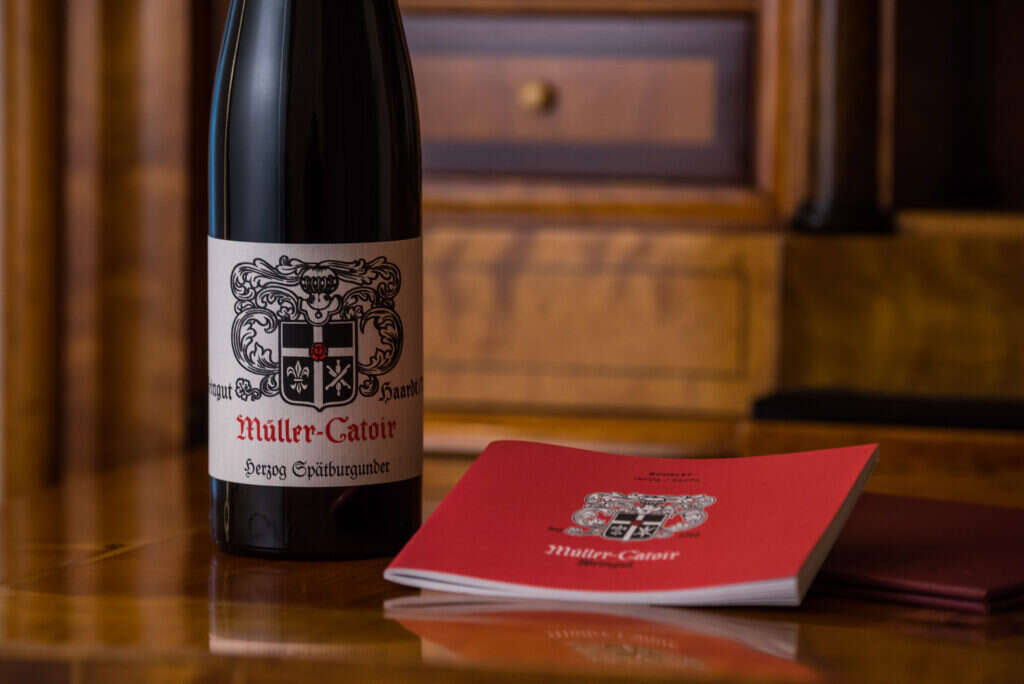
Müller-Catoir Spätburgunder Rosé 2021
This joins the superb rosé from Caroline Diel as a high water mark for class in this category, though Diel’s wine is richer and this one is more filigree. One would expect Franzen to limn the outer limits of diction in his pink wine, and so he does.
It’s the rosé you imagine they drank at the court of Versailles, as they made their arch remarks and remembered to extend their pinkies. That doesn’t mean it’s effete; it means it’s refined, and this is a word seldom deployed to describe a rosé. The wine is admirable and courteous in every way. It takes off its shoes when it walks in your door. It’s full of fruit but isn’t “fruity.”
It is exactly the sort of careful, fastidious wine you’d expect the estate to produce, and I give it my full respect. Here was a case where they might easily have pandered, but didn’t.
Müller-Catoir SEKT, Riesling, Brut, NV
30 months on the lees, and from the look of the cork it was probably disgorged about a year ago. It’s as fine as one would expect, with an appealing aroma (lemon balm, and something linking white nectarine with heirloom apples) and yet, while nothing this winery offers is ever careless, this could be even further refined.
Do they keep it for a while post-disgorgement? Have they considered a lower dosage? I’m curious to see where this goes when I taste it again in a couple days, because as it sits in the glass its mid-palate richness arises, and the wine could make a fool of me.
As it happened, it didn’t. There’s an awkwardness here that’s at odds with the prevailing dialect at this address.

